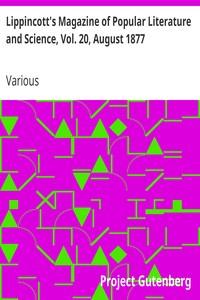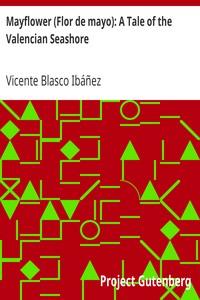|
|
Read this ebook for free! No credit card needed, absolutely nothing to pay.Words: 83875 in 20 pages
This is an ebook sharing website. You can read the uploaded ebooks for free here. No credit cards needed, nothing to pay. If you want to own a digital copy of the ebook, or want to read offline with your favorite ebook-reader, then you can choose to buy and download the ebook.

: Lippincott's Magazine of Popular Literature and Science Vol. 20 August 1877 by Various - Science Periodicals; Literature Modern 19th century Periodicals Lippincott's Magazine@FreeBooksWed 07 Jun, 2023 LIPPINCOTT'S MAGAZINE AUGUST, 1877. DOWN THE RHINE. CONCLUDING PAPER. The Mosel has but few tributary streams of importance: its own course is as winding, as wild and as romantic as that of the Rhine itself. The most interesting part of the very varied scenery of this river is not the castles, the antique towns, the dense woods or the teeming vineyards lining rocks where a chamois could hardly stand--all this it has in common with the Rhine--but the volcanic region of the Eifel, the lakes in ancient craters, the tossed masses of lava and tufa, the great wastes strewn with dark boulders, the rifts that are called valleys and are like the Iceland gorges, the poor, starved villages and the extraordinary rusticity, not to say coarseness, of the inhabitants. This grotesque, interesting country--unique, I believe, on the continent of Europe--lies in a small triangle between the Mosel, the Belgian frontier and the Schiefer hills of the Lower Rhine: it goes by the names of the High Eifel, with the High Acht, the Kellberg and the N?rburg; the Upper Eifel, with Gerolstein, a ruined castle, and Daun, a pretty village; and the Snow-Eifel , contracted by the speech of the country into Schneifel. The last is the most curious, the most dreary, the least visited. Walls of sharp rock rise up over eight hundred feet high round some of its sunken lakes--one is called the Powder Lake--and the level above this abyss stretches out in moors and desolate downs, peopled with herds of lean sheep, and marked here and there by sepulchral, gibbet-looking signposts, shaped like a rough and set in a heap of loose stones. It is a great contrast to turn aside from this landscape and look on the smiling villages and pretty wooded scenery of the valley of the Mosel proper; the long lines of handsome, healthy women washing their linen on the banks; the old ferryboats crossing by the help of antique chain-and-rope contrivances; the groves of old trees, with broken walls and rude shrines, reminding one of Southern Italy and her olives and ilexes; and the picturesque houses in Kochem, in Daun, in Trarbach, in Bernkastel, which, however untiring one may be as a sightseer, hardly warrant one as a writer to describe and re-describe their beauties. Kl?sserath, however, we must mention, because its straggling figure has given rise to a local proverb--"As long as Kl?sserath;" and Neumagen, because of the legend of Constantine, who is said to have seen the cross of victory in the heavens at this place, as well as at Sinzig on the Rhine, and, as the more famous legend tells us, at the Pons Milvium over the Tiber. The Mosel wine-industry has much the same features as that of the Rhine, but there is a great difference between the French wines, which are mostly red, and the German, which are mostly white. Among the latter hundreds of spurious, horrible concoctions for the foreign market usurp the name of Mosel wine. It is hardly necessary even to mention the pretty names by which the real wines are known, and which may be found on any wine-card at the good, unpretending inns that make Mosel travelling a special delight. The Saar wines are included among the Mosel, and the difference is not very perceptible. The last glance we take at the beauties of this neighborhood is from the mouth of the torrent-river Eltz as it dashes into the Eifel, washing the rock on which stands the castle of Eltz. The building and the family are an exception in the history of these lands: both exist to this day, and are prosperous and undaunted, notwithstanding all the efforts of enemies, time and circumstances to the contrary. The strongly-turreted wall runs from the castle till it loses itself in the rock, and the building has a home-like, inhabited, complete look; which, in virtue of the quaint irregularity and magnificent natural position of the castle, standing guard over the foaming Eltz, does not take from its romantic appearance, as preservation or restoration too often does. The Rhine itself is becoming so uninteresting that it is hardly worth while lingering on its banks, and as we get near thrifty Holland the river seems to give itself up wholly to business, for between Cologne and Aachen are miles upon miles of manufactories, workshops and mills; warehouses connected with coal-mines; dirty barges blackening the water; iron-works and carpet-mills; cloth and paper-mills and glass-works--a busy region, the modern translation of the myth of gnomes making gold out of dross in the bowels of the earth. Aachen has a double life also, like many Rhine towns: it is the old imperial coronation city, the city of Charlemagne, with a corona of legends about it; and it is also the modern spa, the basket of tempting figs with a concealed asp somewhere within, a centre of fashion, gossip and gambling. How is it that people who profess to fly from the great capitals for the sake of a "little Nature" are so unable to take Nature at her word and confess her delights to be enough for them? They want a change, they say; yet where is the change? The table is the same, high-priced, choice and varied; the society is the same, the gossip is the same, the amusements are the same, the intrigues the same; the costume equally elaborate and expensive; the restless idleness as great and as hungry for excitement: all the artificiality of life is transported bodily into another place, and the only difference lies in the frame of the picture. Exquisites from the capital bring their own world with them, and their humbler imitators scrape together their hard winter's earnings and spend them in making an attempt cavalierly to equal for a short time the tired-out "man of the world" and "woman of fashion." Some come to find matches for sons and daughters; others to put in the thin end of the wedge that is to open a way for them "into society;" others come to flirt; others to increase their business relations; others to out-dress and out-drive social rivals; others to while away the time which it is unfashionable to spend cheaply in the city; others for--shall we say higher? because--political causes: few indeed for health, fewer still for rest. You see the same old wheel go round year after year, with the same faces growing more and more tired and more and more hopeless. It is so strange to come upon a purely modern town in this neighborhood that Exefeld strikes us as an anachronism. It is wholly a business place, created by the "dry-goods" manufactures that have grown up there, and are worth twenty million thalers a year to the enterprising owners, who rival French designs and have made a market for their wares in England and America. This is a great foil to old Roman Neuss, with its massive gates, its tower attributed to Drusus--after whom so many bridges and towers on the Rhine are named--and even to D?sseldorf, which, notwithstanding its modern part, twice as large as its old river front, has some beautiful antique pictures to show us, both in the costumes of its market-women, who wear red petticoats with white aprons and flapping caps, and stand laughing and scolding in a high key by their dog-drawn carts, and in its council-house, an early Renaissance building with square, high-roofed turrets overlooking the market-place. In that little house, in a narrow street leading to the market, Heine was born; in that wretched little architectural abortion, the theatre, a critical audience listened to Immermann's works; and in the Kurzenstrasse was born Peter von Cornelius, the restorer of German art. Schadow succeeded him at the head of the Academy, and a new school of painting was firmly established in the old city, which had energy enough left in it to mark out another successful path for itself in trade. The new town is handsome, monotonous, rich and populous, but the galleries and museums somewhat make up for the lack of taste in private architecture. One of the most beautiful of the town's possessions is the old Jacobi house and garden, rescued from sale and disturbance by the patriotic artist-guild, who bought it and gave the garden to the public, while the house where Goethe visited his friend Jacobi became a museum of pictures, panelling, tapestry, native and foreign art-relics, etc., all open to the public. The gardens, with their hidden pools and marble statues, their water-lilies and overarching trees, their glades and lawns, have an Italian look, like some parts of the Villa Borghese near Rome, whose groves of ilexes are famous; but these northern trees are less monumental and more feathery, though the marble gods and goddesses seem quite as much at home among them as among the laurel and the olive. LADY BLANCHE MURPHY. VERONA Free books android app tbrJar TBR JAR Read Free books online gutenberg More posts by @FreeBooks
: Rural Hygiene by Ogden Henry N Henry Neely - Sanitation Household; Rural health@FreeBooksWed 07 Jun, 2023

: An Ethnologist's View of History An Address Before the Annual Meeting of the New Jersey Historical Society at Trenton New Jersey January 28 1896 by Brinton Daniel G Daniel Garrison - History@FreeBooksWed 07 Jun, 2023
|
Terms of Use Stock Market News! © gutenberg.org.in2025 All Rights reserved.






